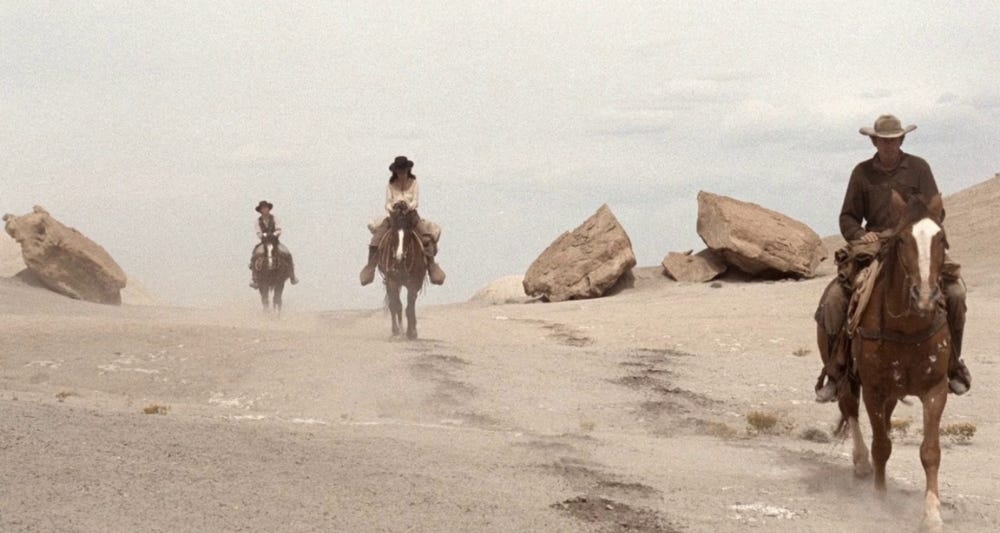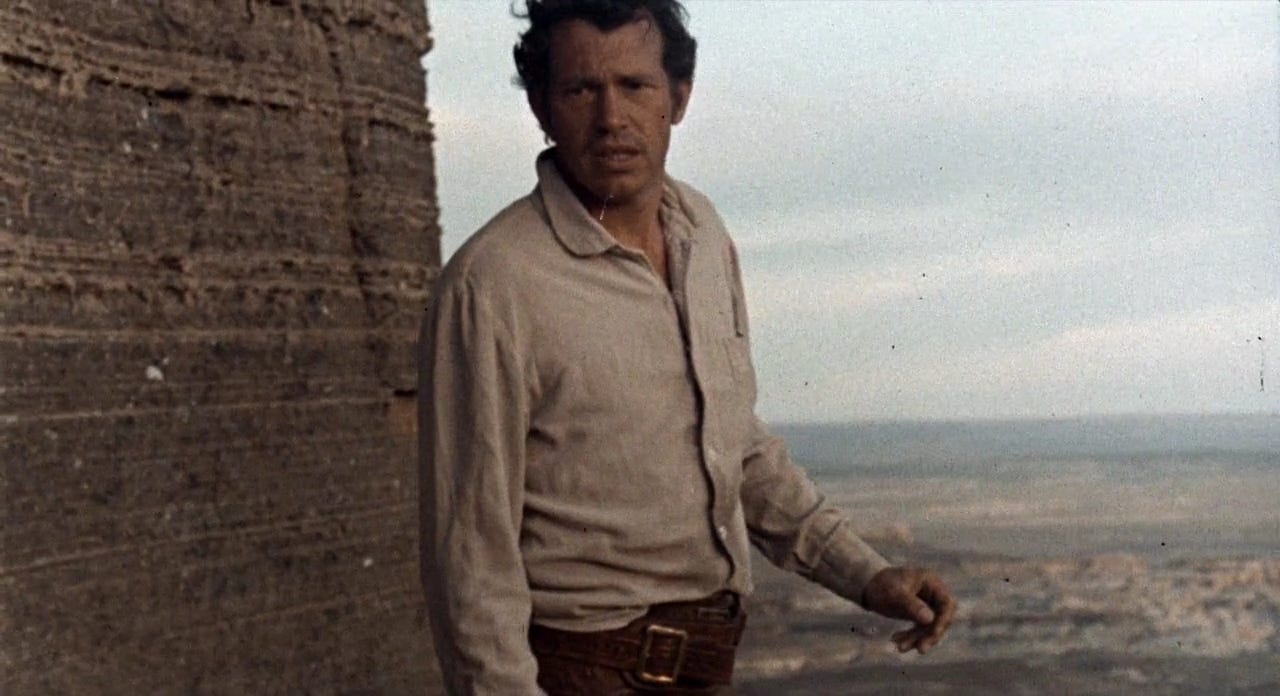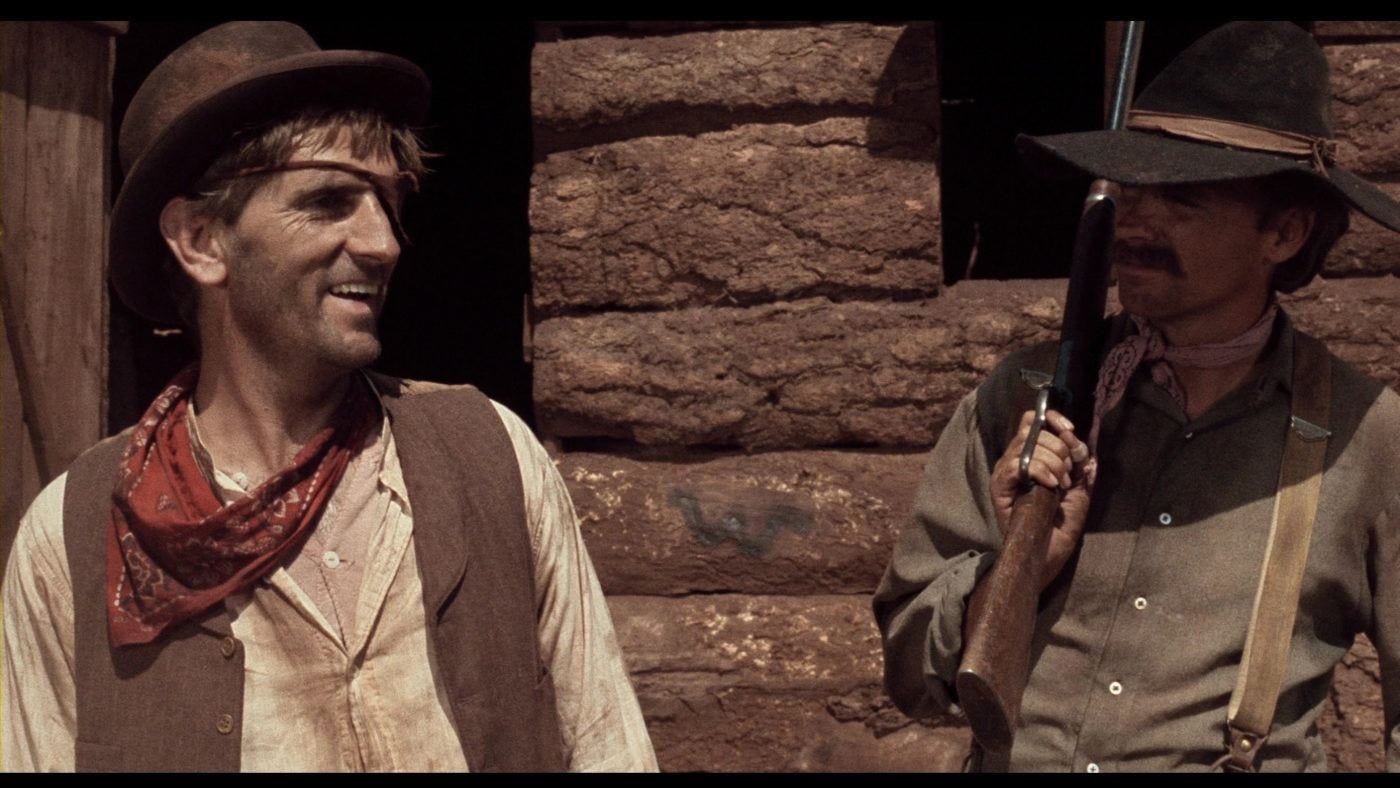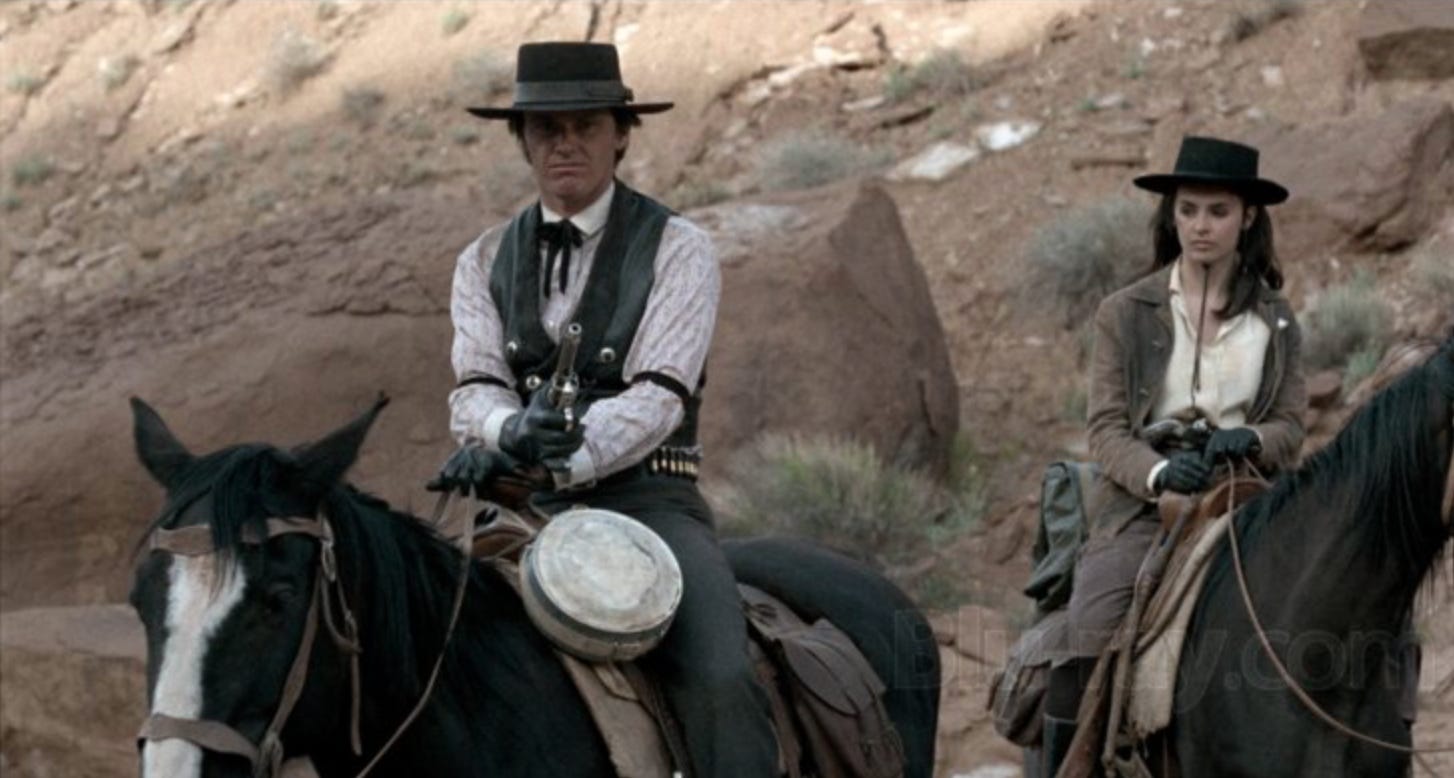The Crowded, Lonesome West of Utah’s Kane County
A pair of Monte Hellman Westerns capture the cinematic contributions of a beautiful, desolate stretch of southern Utah.
At the west end of the appropriately named Center Street in Kanab, Utah, you’ll find an establishment called Little Hollywood (alternately, Little Hollywood Land), a place that takes its name from the town’s now-antiquated nickname and bills itself as a combination museum, chuckwagon, and trading post. It’s essentially a gift shop attached to a barbecue, but it’s a collection of buildings left over from movie sets that draws in the tourists.
Wandering in while on vacation recently, my family was greeted by a friendly clerk who immediately asked if we were looking for the movie sets and then pointed the way toward a seemingly random assortment of buildings in the style of the American frontier, most constructed for long-forgotten westerns. There are exceptions, like a couple of buildings from The Outlaw Josey Wales and Sergeants 3 (and a building facade used in a Kenny Loggins concert filmed at the Grand Canyon in 1991), but most of the collection could have appeared in virtually any Western from any era.
That anonymity doesn’t mean Little Hollywood isn’t worth a stop, however. In fact, it kind of sums up why Kanab and Kane County, for which the small city serves as county seat, were once the go-to locations to shoot Westerns at the height of the genre’s popularity. Monument Valley may offer the most instantly recognizable Old West vista, thanks to its majestic and unmistakable rock formations. But if you close your eyes and think of a Hollywood western, you’re probably picturing a place like Kane County, which offers a variety of locations synonymous with the genre, from canyons dotted with pines to desolate landscapes that stretch to the far horizon. It’s the Stereotypical Barbie of western movie filming spots.
In fact, you may be picturing Kane County itself, thanks to its many screen appearances. Tom Mix shot a film called Deadwood Coach in Johnson County in 1924 and in the years that followed, it served as a location for such notable westerns as Raoul Walsh’s The Big Trail, John Ford’s Stagecoach and Fort Apache, Howard Hawks’s El Dorado, on through Richard Donner’s Maverick in 1994, in addition to being used in non-westerns like The Greatest Story Ever Told, both the 1968 and the 2001 versions Planet of the Apes, Broken Arrow, and, well, Beastmaster 2: Through the Portal of Time. (The region’s tourist website features an extensive list of productions made in the area.) Somewhere outside of town, you’ll find the ruins of a western town that’s been misleadingly promoted as the primary filming location for the long-running TV series Gunsmoke, which was largely shot in California. But the idea that Gunsmoke could have filmed there doesn’t seem that far-fetched. It’s an Old West anywhereland.
That makes it the perfect location for The Shooting and Ride in the Whirlwind, a pair of low-budget westerns directed by Monte Hellman that shot there in the mid 1960s in which the Old West serves as both a setting and the philosophical manifestation of an unforgiving universe. It’s a place that resists any human efforts to impose order or reason upon it and attempts at connection prove as fleeting as they are futile. The films could take place in Utah or Arizona or Colorado, but their real setting is the edge of a void.
Their unlikely origin story involves Hellman and Jack Nicholson pitching Roger Corman on an abortion drama to which Corman, who would finance the films and serve as an uncredited producer, suggested they make a western instead. In fact, why not make two movies instead of one, as Hellman had just done with a pair of thrillers shot in the Philippines? Agreeing, Nicholson got to work on the script that would become Ride in the Whirlwind while future Five Easy Pieces writer Carole Eastman, working under the name Adrien Joyce, wrote the script for The Shooting.
Of the two, Ride in the Whirlwind is the more conventional, though it could never be mistaken for a normal western. Nicholson stars as Wes who, with Vern (Cameron Mitchell) and Otis (Tom Filer), make up a trio of hapless cowboys whose journeys lead them to take shelter with a group of outlaws led by the one-eyed Blind Dick (Harry Dean Stanton). They quickly realize that their hosts are criminals but calculate that their best move is to pretend otherwise until they can leave, figuring that the gang would gain nothing by harassing them and only risk exposure. This proves correct, but when a band of vigilantes show up at the hideout, Wes and the others find themselves mistaken for criminals themselves and have to make a desperate attempt to flee.
The set-up sounds simple enough, but the execution is quite complex. Wes and his friends’ evening with the criminals plays out as an almost comically tense exercise in strained politeness, as they trade stories and pass the time like nothing is amiss. (Of course Blind Dick’s wounded companion fell on his knife. That just makes sense!) Wes and his friends know they’re no good and Blind Dick and the rest of the gang know they know. But everyone plays along for the greater good. Later, when Wes and Vern take shelter in a farmer’s house, a similar game plays out. And, as before, the tension never breaks. Where another film would swerve into a romance between Wes and the farmer’s pretty daughter Abigail (Millie Perkins), Ride in the Whirlwind just doesn’t, simply following the protagonists’ flight through an unforgiving land. Their plight becomes almost Kafka-esque. They’re innocent men who recognize any attempt to prove their innocence or reason with their pursuers would be futile. All they can do is flee and let their flight define who they are.
When I interviewed Hellman in 1999, he resisted the existential label applied to his work. “I think maybe in some interview years before, I said that Albert Camus and Jean-Paul Sartre were at least philosophical influences,” he said before adding that his next film would be his first truly existential film in the classic sense. (I don’t know if he was referring to what would be the only other film he made before his 2021 death at the age of 91, Road to Nowhere, but that overlooked gem matches the description in many ways.) And yet, early in The Shooting, Hellman offers an exchange that doubles as a concise western-friendly definition of existentialism. “I hear you’re a bounty hunter, Mr. Gashade,” a character identified only as “The Woman” (Millie Perkins, again) asks Willett Gashade (Warren Oates), the man she’s hired to lead her to a place called Kingsley for reasons unknown. “I wouldn’t name myself that. It was just a way of making wages once.”
Accompanied by Willett’s naif-like companion Coley (Will Hutchins) and, later, by a sneering gunman named Billy Spear (Nicholson) in league with the Woman, they make their way across an arid plain. Coley and Willett know where they’re going but not why. Billy and the Woman know why they’re making the journey but not where it will take them. The two halves of the party do not trust each other and have no reason to. The answer might lie in the recent past. Willett and Coley suspect the Woman and Billy’s quest might have something to do with Willett’s brother Coigne, who disappeared after an incident in the nearby town of Winslow. Coigne, Coley tells Willett though he didn’t witness it himself, “ran a man and a little person down in the streets of Winslow. Maybe a child.”
What happened, The Shooting never reveals and a final scene in which reality itself appears to break down raises more questions than answers. Even before that point, the film becomes increasingly abstract. The tension between the characters intensifies even as the details of their situation becomes less clear. Who is this woman that employed Willett and Coley? Who is the seeming sadist who rides beside her? Where does this trail end? Does it end? Hellman’s previous work included a production of Waiting for Godot staged as a western. In some ways, this is a reprise.
“Samuel Beckett’s influence is felt so strongly in Monte Hellman’s films that even if one were not aware of Hellman’s oft-professed love of Beckett, it wouldn’t be all that difficult to guess,” Sheila O’Malley wrote of the director in a 2021 appreciation of the great Two-Lane Blacktop. But where Beckett is often staged on the barest of stages, Hellman sought out the Kanab area for these films. (“There certainly were a lot of people urging us to shoot in California,” he told me in the same interview.) The vistas of both The Shooting and Ride in the Whirlwind instantly establish the setting as the West, but the images offer no specifics. In films that strip dialogue and exposition to the bare essentials, the setting responds in kind. They don’t take place against the backdrop of sweeping majesty, though the nearby Grand Staircase would have offered one of those. They’re as plain and unforgiving as the lives they depict.
Some of the specific spots used in the film no longer exist. In a special feature included on the Criterion Collection disc of both films, Hellman returns to Utah and finds that the artificially created Lake Powell now covers some of the filming locations. But even this feat of engineering is just a blip on the landscape. You can easily visit the West of Hellman’s film by traveling just a few miles away from the Little Hollywood museum that serves as the final resting place for other movies made in the area. It seems to go on forever and looks like the sort of place where it would be easy to get lost.









Wonderful writeup, Keith. THE SHOOTING is one of my favorite Westerns, if not my favorite. RIDE IN THE WHIRLWIND is also very great. These are the films that introduced me to Monte Hellman, thanks to the Criterion Blu-ray. Excited to read your interview with him!
Great writeup! These are both on my list of need-to-see Westerns (and they get mentioned in film historian James D'Arc's excellent When Hollywood Came to Utah for those interested in learning more about the area.)